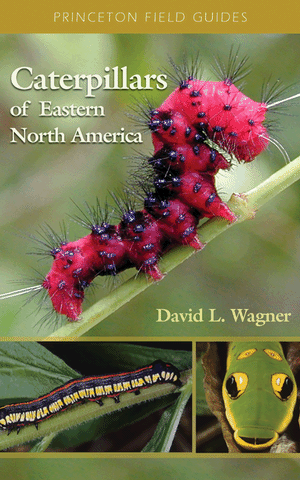This summer, I have come across a number of caterpillars that I haven't seen before. Fortunately, with my new book, Caterpillars of Eastern North America by David L. Wagner, I am able to identify what I have found.
I don't know about you, but I am far more likely to find caterpillars than butterflies (or moths). Maybe it's just that I have a better chance of capturing the sedately wandering caterpillar than the zigzagging butterfly with my camera. In the past, I would struggle to identify what I had found. That was because I had only a butterfly book to work with. The problem with the butterfly book is that it is a book to identify the adult butterfly, not the larval caterpillar. It contains only a small section with plates of caterpillars, and it is limited to butterfly caterpillars only.
 Then I bought Caterpillars of Eastern North America by David L. Wagner. This guide has been invaluable. The introductory section, which in my zest to identify a particular caterpillar, I will admit, has largely gone unread, is full of interesting information. Topics covered include not only morphology and life cycle, but also where and when to search for caterpillars, how to rear and feed them, how to photograph them and projects for schools, nature centers and universities. What I have read from the introduction is very informative and I do plan to go back and read through all of it.
Then I bought Caterpillars of Eastern North America by David L. Wagner. This guide has been invaluable. The introductory section, which in my zest to identify a particular caterpillar, I will admit, has largely gone unread, is full of interesting information. Topics covered include not only morphology and life cycle, but also where and when to search for caterpillars, how to rear and feed them, how to photograph them and projects for schools, nature centers and universities. What I have read from the introduction is very informative and I do plan to go back and read through all of it.The pages for the caterpillars themselves are fantastic! At the top of the page is a large picture of the caterpillar. Below that is a smaller picture of the adult butterfly or moth and then information that includes how to recognize the caterpillar, where it occurs (in what type of habitat and where in North America), common foodplants, and remarks. Here are some remarks for a Wooly Bear:
According to "rural legend," the width of the orange band can be used as a predictor of the severity of the coming winter, with narrower bands forecasting colder winters. In fact, the width is quite variable in character. At each molt, a portion of the black setae is replaced by orange, and hence the orange band is broadest in the last instar.
I think identifying caterpillars is fun. It is almost like opening a present, because you can't tell from the caterpillar what the butterfly or moth is going to look like. I'm always filled with hope that I will have found the caterpillar of some rare or beautiful butterfly. Unfortunately, that tends not to be the case, but the anticipation is there each time.
And look at these guys! Even though the moths that they will eventually become are rather plain, in their youth, they were rock stars!
 |
| Milkweed Tussock Caterpillar (Northern CT - August, 2012) |
 |
| Banded Tussock Moth (Mid-coast Maine - August, 2012) |
 |
| Mottled Prominent (Mid-coast Maine - August, 2012) |
 |
| Red-humped Oakworm (Mid-coast Maine - August, 2012) |
 |
| Yellow Bear (Virginia Tiger Moth) (Mid-coast Maine - August, 2012) |
See my disclosure policy on the bar at the top of the page. This book was purchased by me for my own use and I do not receive any compensation for reviewing it or from Amazon if you decide to purchase it.
No comments:
Post a Comment